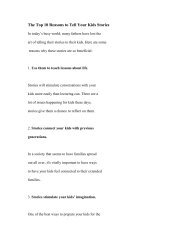Organic Chemistry
Chirality
Chirality
You also want an ePaper? Increase the reach of your titles
YUMPU automatically turns print PDFs into web optimized ePapers that Google loves.
<strong>Organic</strong> <strong>Chemistry</strong> - Ch 11 541 Daley & Daleynumber, 2, goes to Cl, which has an atomic number of 17. Then comesF, priority number 3, with an atomic number of 9, and finally H,priority number 4, with an atomic number of 1. If the atoms aredifferent isotopes of the same element, prioritize them according toatomic weight, giving the heaviest isotope the highest prioritynumber. For example, tritium ( 3 H) comes before deuterium ( 2 H),which comes before hydrogen ( 1 H).If there is a tie, use the atoms bonded to the tied atoms todetermine which gets the higher priority number. For example,consider a stereogenic carbon attached to an isopropyl (—CH(CH 3 ) 2 )group and an ethyl (—CH 2 CH 3 ) group. Before going any further, makea molecular model. For the other two groups attached to thestereocenter, use any two different atoms (H and Br, for example). Thename of such a molecule is 3-bromo-2-methylpentane. Br and H getpriority numbers 1 and 4 respectively, but because the other twogroups begin with a carbon, there is a tie for numbers 2 and 3. Tobreak the tie, you must compare the atomic numbers of the otheratoms attached to each of the two carbons. The first carbon of theethyl group is bonded to two hydrogens and one other carbon. In theisopropyl group, the first carbon is bonded to one hydrogen and twoother carbons. Thus, the isopropyl group has the higher prioritybecause it has two other carbons in contrast to only one other carbonin the ethyl group.When considering groups bonded to a stereogenic carbon in acyclic compound, start one group with the atom immediately to theright of the stereocenter and start another group with the atomimmediately to the left of the stereocenter. In the case of a tie in acyclic compound, continue around the ring until you find a difference.In the example below, the first point of difference is the directionaround the ring that comes to the double bond first.First point ofdifference21OH3CH 34To determine the priority number of atoms involved in a doubleor triple bond, treat the multiple bond as if it were broken into thecorresponding number of single bonds with the atoms at each end ofthe multiple bond doubled or tripled.www.ochem4free.com 5 July 2005







